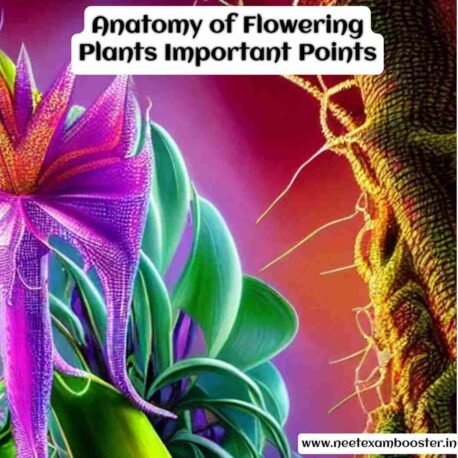Anatomy of flowering plants important points: Anatomy of a flowering plants consists of the various specialized structures and the tissues that performs various different functions such as support, transport of the water and the nutrients, photosynthesis, and the process of reproduction. Flowers contains the male and the female reproductive structures, stamen and pistil respectively.
Stem and leaves are involved in the process of photosynthesis, and root is responsible for absorbing the water and the minerals. Tissues that are found in the flowers includes the epidermis, cortex, pericycle and the vascular tissue, which consists of the xylem and the phloem. The process of fertilization leads to formation of seeds and fruit, which protects and disperse the seeds.
Plant anatomy is very important for understanding structure and functions of the plants, as well as its evolution, applications in horticulture, agriculture, and forestry.
Anatomy of Flowering Plants Important Points, Anatomy of Flowering Plants Important Points, Anatomy of Flowering Plants Important Points, Anatomy of Flowering Plants Important Points, Anatomy of Flowering Plants Important Points
Biology Class 11 Chapter 6 NCERT 25 important points- Anatomy of flowering plants important points
There are 25 important points of anatomy of flowering plants

1. The flowering plants are the vascular and have specialized tissues for the transport of water, minerals and food.
2. The flowers are reproductive organs of the flowering plants, and they contains male and the female reproductive structures.
3. Stem of a flowering plant is responsible for the support and transportation of water, minerals and the food.
4. Leaves are main photosynthetic organs of the plant and contains the green pigments known as chloroplasts.
5. Root is the organ responsible for absorbing the water and minerals from the soil.
6. Root is also involved in anchoring the plant and providing it stability.
7. Stem and leaves both are involved in photosynthesis.
8. Flowers contains four main types of tissues these are the epidermis, cortex, pericycle and the vascular tissues.
9. The outermost layer of stem and root is known as the epidermis.
10. Cortex is the region between epidermis and the vascular tissues and is involved in the process of storage of food and water.
11. Pericycle is a layer of tissue i.e. located between cortex and vascular tissue, and it is responsible for the lateral growth of the plant.
12. Vascular tissues consists of the xylem and the phloem, and is responsible for the transportion of water, minerals and food.
13. The flowers contains both male and female reproductive organs, the stamen and the pistil, respectively.
14. Stamen is the male reproductive organ that consists of the anther and filament.
15. Anther is the part of the stamen that produces and releases the pollen.
16. Filament is the stalk that holds the anther in its place.
17. Pistil is the female reproductive organ that consists of the stigma, style and ovary.
18. Stigma is the part of the pistil that receives the pollen grains.
19. Style is the stalk that connects the stigma to ovary.
20. Ovary contains the ovules, which will develop into the seeds after the process of fertilization.
21. The process of fertilization occurs when a sperm from pollen travels down the style of the ovary and fertilizes the egg in the ovule.
22. Ovary later develops into the fruit, which protects and disperses the seeds.
23. Seeds contains the embryo plant and a food supply, which will be used to support growth of a new plant.
24. Anatomy of a flowering plant is adapted to its specific environment and conditions it needs to survive.
25. Study of the plant anatomy is important for understanding structure, function and evolution of plants, as well as for the horticulture, agriculture and forestry.
Some Important Questions From Biology Class 11
| Chapter Name | Quiz Link |
| The Living World | Play Now |
| Biological Classification | Play Now |
| Plant Kingdom | Play Now |
| Animal Kingdom | Play Now |
| Morphology of flowering plants | Play Now |
| Anatomy of flowering plants | Play Now |
| Cell: the unit of life | Play Now |
| Biomolecules | Play Now |
| Cell Cycle and cell division | Play Now |
| Transport in Plants | Play Now |
| Structural organisation in Animals | Play Now |
| Mineral nutrition | Play Now |
| Photosynthesis in higher plants | Play Now |
| Respiration in plants | Play Now |
| Plant Growth and development | Play Now |
| Digestion and Absorption | Play Now |
| Breathing and Exchange of Gases | Play Now |
| Body fluids and circulation | Play Now |
| Excretory products and their elimination | Play Now |
| Locomotion and Movement | Play Now |
| Neural Control and Coordination | Play Now |
| Chemical Coordination and Integration | Play Now |
Some Important Questions From Biology Class 12
| Chapter Name | Quiz Link |
| Reproduction in organism | Play Now |
| Sexual reproduction in flowering plant | Play Now |
| Human reproduction | Play Now |
| Reproductive health | Play Now |
| Principles of inheritance and variation | Play Now |
| Molecular basis of inheritance | Play Now |
| Evolution | Play Now |
| Human health and disease | Play Now |
| Strategies for enhancement in food product | Play Now |
| Microbes in human welfare | Play Now |
| Biotechnology principles and processes | Play Now |
| Biotechnology and its application | Play Now |
| Organism and population | Play Now |
| Ecosystem | Play Now |
| Biodiversity and its conservation | Play Now |
| Environment issue | Play Now |



















